


Cerro Gordo County Iowa
Part of the IaGenWeb Project
|
The Globe Gazette


TRANSCRIBER'S NOTE: Some of the language contained in these news articles are not considered to be politically correct by today's standards. They have, however, been transcribed as they appeared in 1953.
[Section 4, Page 2] Functioning as an aid to law enforcement agencies in the early days was the Anti-Horse Thief Association, which operated so effectively that stealing horses became a perilous occupation. An example of the association's work is the case of Samuel Maher. Early in 1879 Maher bought a small place on the Winnebago north of Mason City. Early in April he told neighbors he was going to Kansas City to spend the summer and on the evening of April 3, 1879, came to Mason City and registered at a hotel, leaving orders to be called for the early morning [to catch a train of the] Central of Iowa railroad. Everyone presumed he boarded the train.
The following night (Friday) farmers at a meeting of the Lime Creek Farmers club at the Vinton School discovered their horses were gone. The alarm was given and C. B. Dike rallied the Anti-Horse Thief Association which started riders out in all directions. Information was telegraphed to sheriffs in surrounding counties. The trail of the horses led toward Fertile. The search continued through the weekend and on Monday morning Dike received a telegram from the sheriff at Albert Lea that the horses were there and the thief in jail. Imagine the astonishment of Sheriff Schell and Dike to find the thief was none other than Sam Maher, he who has started for Kansas City Friday morning. He was extradited, brought back for trial and sentenced to the penitentiary. Money was not so plentiful in those days and bartering was often used. Sometimes horses were a medium of exchange. Atty. W. C. Stanbery one time went to Forest City to handle cases for several clients. He stayed several days and when he returned he brought with him a whole string of horses. He had gotten a good fee. The leading spirits in the organization were C. B. Senior and H. I. Smith, close friends and able musicians. The orchestra, which had about 12 instruments, was directed by Senior, who played first violin. Arthur Pickford, many years later Globe-Gazette farm editor, played the flute. John Avery played the flute and Smith, double bass. Curtis Bates and Baker Huntley played the French horns. The orchestra members realized that at times their music was over the heads of their audiences, who would rather have heard "Sweet Bye and Bye" than "Barber of Seville," but as it seldom made any charge the public had to take what the orchestra played.
These orchestra members, however, had a part in raising the musical standards of the community. Occasionally a theatrical troupe came to town and needed extra music, in which events the orchestra played for complimentary tickets. When the Congregational Church bought its first pipe organ for the old stone church, now part of the Sunday School rooms of the congregation, the orchestra assisted at the opening. Some members of the church doubted the propriety of bringing fiddles and other instruments in the church, but the more liberal element prevailed when the orchestra performed.
WOMEN DRESSED in GUNNY SACKS for "POVERTY PARTY" [Section 4, Page 2] A high mark in the early social events of Clear Lake was reached in the "poverty party" held in 1878 at Etzel hall. This event was revealed in a program printed on brown wrapping paper in keeping with the character of the party. John G. Phillips, for many years subscription manager for the Globe-Gazette, was one of the 50 or 60 couples attending the function. Women came dressed in gunny sacks, while the men wore boots, ragged overalls and hickory shirts. Square dancing to the music of an old-fashioned orchestra made up of fiddle and organ was the chief diversion of the evening. Admission to the party was 9 cents.
HENRY SHEPARD FAMILY IN 1879
NOTE: Henry Harrison Shepard was born September 24, 1840, and died September 13, 1893. Hugh H. Shepard was born in 1876, and died in 1970. They were interred at Elmwood-St. Joseph Cemetery, Mason City.
1880: CONTROVERSY OVER SALOONS PLAGUED PIONEERS in MASON CITY
The church is the Union Memorial Methodist on the corner of 4th and Carolina N. E. The story of how this came to be is an interesting one. Intoxicating liquor had been the course of much controversy in the early days. Saloons flourished here in the rough and ready days of the pioneers, but the influence of the church finally came to bear to the extent that in 1880 the city council passed an ordinance prohibiting the sale of all intoxicating liquors in the city.
Another important commercial development was the organization of E. B. Higley and Company on May 1, 1880 by Edward Higley and Cornelius O'Keefe, making butter and cheese. Later the company came to handle produce and became a manufacturer of ice cream. Mason City's liquor ordinance came after years of repeated efforts to vote out saloons. The passage of the ordinance did not end the city's troubles. The city fathers showed signs of vacillations. The matter was finally decided when the state voted in July, 1882, to prohibit the sale of all intoxicating liquors. Mason Township voted 845 to 34 for this amendment. But for a decade preceding this event, Mason City was stirred by a controversy between the wets and the drys. The campaign to get rid of the saloons started at least as far back as 1872. In January of that year a large group of church members marched in a body to the saloons and held prayer meetings. This followed a newspaper announcement that the city council had again voted to license the saloons at $200 a year. On Nov. 29, 1879, the city council passed Ordinance No. 79, prohibiting the sale, gift, keeping with intent to sell ale, beer, wine, cider, and other intoxicating liquor. later cider was excluded from the list and on Dec. 2 another draft of the ordinance was adopted as No. 85 and went into effect in January, 1880. On April 30, 1881, Ordinance No 86 was adopted, permitting sale of beer, malt and vinous liquors to licensed persons. The following Oct. 24, the city fathers adopted a resolution prohibiting the sale of beer or any other intoxicating drinks to a certain list of persons. For several meetings after this the council was called upon to withdraw names from this embarrassing list. The state amendment finally settled the matter, despite the fact that it was later thrown out of court on the grounds of some irregularity.
At the time the law went into effect Mason City had two breweries, which, of course, immediately ceased operations. One stood on the site of the present Union Memorial Church and the other farther up the Winnebago River. The real estate records indicate the brewery industry must not have been too profitable. On the 4th and Carolina site, the business was started by Samuel Wyatt and Joseph Dorfner, who bought the property in 1871 from Daniel and Joseph Farrell. The next year Wyatt transferred his interest to John Bauman. In 1875 E. R. Lloyd got the property on a sheriff's deed, showing business was down during the big depression of the 70's. It passed successively into the hands of Michael Brahm, H. W. Burdette, Carrie Collins and Frank B. Abbott (north half) and Mike Kelly (south half). By that time it ceased to be a brewery. In the metamorphosis of the property from brewery to church, there were interesting developments. In 1889 the brewery was made into a creamery, operated by the Mason City Creamery Co. O. T. Denison was president and A. J. Miller, father of Frank Miller, secretary. In 1892 Sam and Joe Kennedy took over the business, selling to H. J. Turner in 1895. Later it became the J. D. Bickel Produce Company and in 1910 was conveyed to Helen Lester Booth, who deeded it to Hugh H. Shephard, with C. H. McNider holding half interest. On Oct. 23, 1913, Shephard and McNider sold the property to the Rev. F. W. Douglas Woodford, Negro minister. The deed was made out to the First Methodist Church, as the custodian of the property, on which the Union Memorial church was erected.
HAD STRANGE SPELLING [Section 4, Page 2] That modern orthography had been neglected in the early eduction of some of the bar members appears in their written pleadings. Such spelling as "pigg," "waggon," "brake" and "braking praree" indicates.
CITY BAND STAND SOLD AT AUCTION, THEN REPURCHASED [Section 4, Page 2] The city's bandstand, which stood for many years in Central Park, was once sold at auction and later repurchased by the city. Funds for building the band stand back in the early days were raised by voluntary subscriptions. The frame work on the bandstand went up and stood unfinished for several years because of the lack of funds. Finally funds were procured and the bandstand completed. It was used by the city as a restrum for all types of occasions and for bandstand purposes. Then someone thought the central spot in the park should have a fountain and fish pond. Some of the musicians in the town staged concerts for the purchase of the fountain, which was obtained and installed. Then the question arose as to where to place the bandstand. It was finally decided to sell the bandstand. It was sold at auction and purchased by a contractor, who removed it to his residence on 12th N.W. and it stood there for several years. When the newness of the fountain had worn off the residents of the community began to long for the return of the bandstand with band concerts and other entertainment. The city park commission purchased the bandstand and placed it in the park again. Later it was moved to East Park.
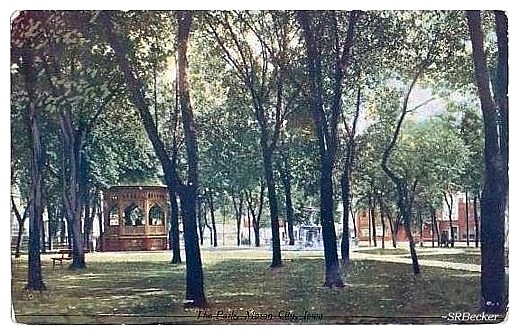
TWINE BINDER IMPROVED BY FLOYD FARMER [Section 4, Page 2] One of the significant milestones in the progress of the farmer was the invention of the twine binder, a machine that not only cut the grain but bound it into bundles, tying the twine knot with an ingenious device invented by John F. Appleby of Mazonmani, Wis. This binder was first put on the market in 1879, but for the first few years there was trouble until the knotter was perfected. A Floyd County farmer had a part in perfecting this binding device. This is the story: The Deering Company in 1880 sold six machines in Osage, only one of which was settled for. Five of the farmers returned their machines with the declaration that they would not work. Deering wondered why the sixth farmer did not return his binder and wrote to the agent at Osage to learn his name. Learning that he was John Webster, who farmed near Floyd, Deering wrote to Webster and asked him to come to Chicago at the company's expense. "Why was it you did not return your binder?" asked Mr. Deering. "Because I rebuilt it and made it work," was the answer. "I want you to show me just what you did," said Deering. After being shown the improvements made by Webster, Deering offered the Floyd farmer $100 a month to come to Chicago and join the company force. Webster rented his farm and moved to Chicago. In the fall of 1882 Webster made his great improvement in the grain binder and what is known as the Webster knotter resulted. NOTE: J. W. Webster applied for a patent on on February 1, 1883
which was awarded May 29, 1883 (Patent No. 278,639). In this application, Webster stated, "The object of my invention is to simplify
the mechanism for actuating the cord-holder, and at the same time to obviate certain defects in the class of
binders to which my invention is applicable; and its nature consists in providing novel means for actuating the
intermittently-rotating cord-holder that shall at the same time operate as means for retaining the same in a fixed
position of rest during said interments. I have shown my invention as adapted to a form of binder now much used."
Derring brought suit in Minnesota against McCormick Harvesting Machine Company and Winona Harvester Works, claiming both companies had infringed upon Webster's patents. On November 30, 1889, the case was dismissed against McCormick but held that Winona Harvester Works did indeed infringed upon Webster's patents No. 278,639 and No. 301,190. SOURCE: law.resource.org/pub/us/case/reporter/F/0040/0040.f.0236.pdf
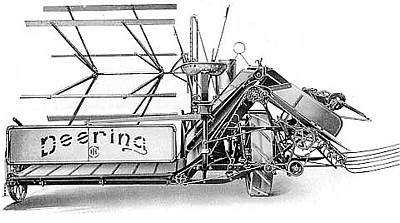
1881: MASON CITY BECOMES CITY of SECOND CLASS [Section 4, Page 4] The previous year's census, having shown Mason City's population over the 2,000 mark, the municipality in 1881 was organized as a city of the second class. New ordinances were adopted and John Cliggitt, eloquent member of the bar, became the city's first mayor under the new setup, in which the city was divided into three wards. The first officers under the new government included Alonzo Church, treasurer; John C. Sherwin, city solicitor; J. J. Clark, clerk; D. H. Baker, marshal; and the following councilmen: First ward, John Lee and Henry Keerl; Second ward, Andrew Lien and B. P. Kirk; Third ward, L. A. Page and John F. Burns. Cliggitt served as mayor until 1884, when he was succeeded by another eminent member of the bar, J. C. Sherwin, later member of the supreme bench in Iowa. In 1885, O. T. Denison, brick and tile magnate, was named mayor. It was under him that the famed Denison Hose Company was organized, giving Mason City one of the best volunteer fire departments in the state. Denison was succeeded by C. H. Hughes, and in 1889 J. H. Stevens was elected mayor. He was succeeded by Duncan Rule and from 1892 to 1897 A. H. Cummings served as mayor. George W. Brett was mayor from 1897 to 1901.
NOTE: A. A. Church was born August 25, 1838, and died September 30, 1902. The year 1881 had another significance in Mason City history. On June 12 of that year the C. H. Huntley Post of the Grand Army of the Republic ws organized here. For the next several decades this organization was to exercise a powerful influence on the life of the community. The charter members of the post were: E. A. Doud, J. A. Colton, J. S. Clark, John Beazan, J. R. LeLacheur, C. M. Adams, George E. Poisell, S. C. Ransom, C. E. Baker, F. B. Florence, M. Willis, James Gibson, Digery Daker, H. A. Marsh, William Airhart, A. C. Bemis and E. R. Roberts. During the history of the post 282 members were mustered or admitted by transfer from other posts. Last of the G.A.R. members in Mason City was Rockley Whipple, who died in April [14], 1941, at the age of 101 years. NOTE: Charles Morrill Adams was born December 29, 1843
at Worcester, Massachusetts, served with Co. B 32nd Iowa Volunteer Infantry, and died June 6, 1926, Mason City. The club was organized chiefly through the efforts of J. E. E. Marley and Billy McNider who came to Mason City in the summer of 1881. They missed the Owl Club parties they had attended in Marshalltown and took the initiative in organizing the club here. McNider was an older brother of C. H. McNider. These three, with Skid Ogden, a train dispatcher for the M. and St. L, Harry Lloyd, fuel agent for the M. and St. L., Lyle Hoxsie, M. and St. L. conductor, Ed Pennington, superintendent of the M. and St. L., and Mrs. Barney Lucas, editor of the Cerro Gordo Republican, were active in the early days of the club. NOTE: James E. E. Markley was born in 1857, and died in 1939. William B. "Billy" McNider was born in 1858, and died in 1900. They were both interred at Elmwood-St. Joseph Cemetery. At that time Mason City had two dancing clubs, the Silver Greys and the Appollo Club, but these groups went in for square dances, while the Owl members preferred the new dances such as the waltz, the schottish and the polka. Lloyd and Tuttle's hall, on the present [1953] Montgomery Ward and Company Building site, was the scene of the festivities. Later Parker's Opera House came into use. The program for the fifth annual party of the Silver Greys in 1883, lists the waltz,the schottish, polka, fireman's dance, the lancers, Money Musk and many others. Among the favorites at the Owl Club parties were the waltz quadrille, the prairie queen,the redowa and the York. In the orchestra were two violins, a harp, a clarinet and a base viola. The orchestra leader played second violin so he could call.
GRAND ARMY of the REPUBLIC

[Section 4, Page 4] For a half century the Grand Army of the Republic, organized here in 1881, was a power in the community. Shown above are members of the Charles H. Huntley Post as they appeared on the courthouse steps in 1912, when their ranks were thinning. Reading from the left, they are: First row - Charles Magoon, A. Yelland, W. H. Stott, Thomas Hanlon, unidentified, P. S. Farmer, A. P. Munson, Court Ransom, J. O. Brown, William Nettleton, N. G. Thorn and J. H. Stevens. Second row - Daniel Hill, unidentified, R. D. Patton, James Orr, George Tyler, C. M. Adams, William Weigle, J. M. Rankin, James Clark and A. W. Harmon. Third row - David Spencer, Henry Florence, Thomas Dent, O. B. Swift, Nicholas Grant, Lyman Stevens, Henry Gillett, Pierce Gilbert and C. J. Stevens. Fourth row - Fred Zerel, Fant Florence, V. C. Lewis (sic, should be V. G. Lewis), unidentified, unidentified, J. W. Long, Alba Miller and Frank Vanlone. NOE: Charles Magoon was born November 9, 1842,
served with Co. G 74th Illinois Volunteer Infantry, and died January 1, 1920.
MAYOR 1893 - 1898
NOTE: Albert H. Cummings was born in 1849, and died in 1936. Idella C. Cummings was born in 1851, and died in 1931. They were interred at Elmwood-St. Joseph Cemetery.
/ 1882: CLIGGITT TRIES to GET FEDERAL COURT for MASON CITY
On Feb. 10 of that year the city council petitioned Congress for the establishment of such a court in Mason City. The move was engineered by the resourceful and aggressive John Cliggitt, then serving as mayor of Mason City. The following resolution, no doubt prepared by Mayor Cliggitt, was sent to N. C. Deering, 4th district representative in Congress: "We hereby respectfully present to the Congress of the United States our request that in determining the places of holding terms of the United States courts in Iowa that the convenience and advantages in point of location, railroad facilities, and in other respects which Mason City affords be taken into consideration and if found suitable and proper to Congress that Mason City be designated as one of the places for holding said courts." NOTE: John Cliggitt was born August 25, 1840, and died June 17, 1914. His wife, Ella C. (Brightman) Cliggitt, was born October 7, 1855, and died February 19, 1939. They were interred at Elmwood-St. Joseph Cemetery.
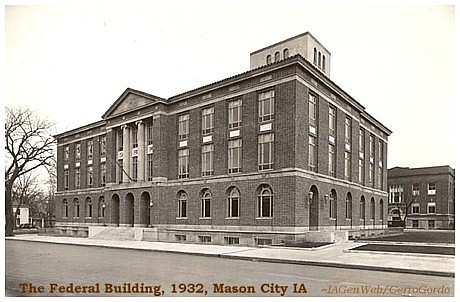
BAGLEY'S C.O.D. GROCERY
[Section 4, Page 4] This picture taken in 1882 shows the grocery store operated by S. S. Bagley, father of the late W. G. C. Bagley. From left are: Fred W. Bagley, brother of Willis; George Gale, delivery wagon driver; Bert Gale, John Hawkins and S. S. Bagley. The store stood on the west side of Federal about the third front south of State.
1883: MASON CITY GETS ELECTRIC LIGHTS [Section 4, Page 6] The first electric power and light plant in Mason City was built in 1883 on the present site of the Eadmar Hotel. Compared with the facilities of the Peoples' Gas and Electric of today it was a primitive establishment. The 1883 plant was financed by E. Pennington, later president of the Soo Railroad,and Dr. J. S. Clark. After a year's operation the plant was shut down. In 1885 the wife of Dr. Clark, Mrs. M. I. Clark, started up the plant with W. P. Fitch as superintendent. They got the plant ready to run on Christmas eve when the system had an excessive load. It ran about an hour when the belt broke, shutting the plant for three days. That winter churches, halls and theaters were forced to wait until some of the business houses closed before they could open and at times a boy was sent around to warn people to turn off some of their lights. In 1892 The Clark Company built the first section of the present plant on the banks of Willow Creek and change the name to the Mason City Electric Company. In 1900 W. E. Brice bought the operation and renamed it Brice Gas and Electric Company. NOTE: William E. Brice was born July 26, 1861 at Rochelle, Illinois. He established the Mason City and Clear Lake Traction Company, one of the earliest interurban railways of Iowa, with Lewis "Lew" Ong who with Brice was originally from Tama, Iowa. BUILT OPERA HOUSE
[Section 4, Page 6] NOTE: Alanson Townsend Parker was born in 1839, Herkimer County, New York, and died in 1925, interment at Elmwood-St. Joseph Cemetery. His cousin, Horace G. Parker, established Parker Flour Mill.
1884: REPORT GOLD BURIED on RIVER BANK [Section 4, Page 6] One of the strange stories that has come down with the years is that of a large sum of gold that reportedly lies buried in a rock niche on the banks of the Winnebago River a few miles northwest of Mason City. The man who buried the gold was Thomas Nelson, mysterious soldier of fortune who had amassed the coin prospecting in the Black Hills after having been with Custer and other Indian fighters in the West. In the summer of 1884 Nelson called at the Wheeler ranch in Cerro Gordo County. He said he had been a gold miner. he got a job and remained at the ranch all summer. One day a neighbor came across Nelson counting gold coins. He had the money stacked in tall piles, the various denominations in separate stacks. Then he put the money into a heavy leather money belt and buckskin bags. The report got around that Nelson kept his money buried somewhere on the ranch. After a year or two there was talk that Nelson was unable to find his buried money. He remained in the county some 10 years, according to old timers who said he spent most of his time traveling up and down the Winnebago River. Nelson admitted to Oliver Booth, a resident of Grant Township, that he had buried a fortune in gold somewhere on the Winnebago River between the Wheeler ranch and horseshoe bend, buried it on a dark night so securely that he, a man who a few years before could out-trail a Pawnee, never found the spot where he had put it down three feet beneath the surface. There had been trees and rocks, he said, where he dug down the gold. The result was that instead of leaving the community as he no doubt planned, Nelson remained. He spent months at a time trampling back and forth at a point near the horseshoe bend west of Dexter's bridge. The constant travel across the land of one farmer resulted in a trespass charge, for which a trial was held before a justice court in Clear Lake. Nelson was acquitted [the farmer admitted that Nelson had caused no damage to the property] and resumed his strange quest. But the gold was never found. Three feet beneath the surface in heavy leather belt and buckskin bags, it lies awaiting the treasure seeker with a lucky hunch. The lure of gold finally drew Nelson to the Klondike in 1898. He came back in the fall of 1900 [reportedly walking the river bank daily] and returned to Alaska in the following summer. There he died in 1924. The search for Nelson's lost treasure became a popular activity for locals during the years of the twentieth century. Reportedly, no one ever claimed to have found Nelson's treasure.
1885: MASON CITY WOMEN FORM EQUAL SUFFRAGE CLUB [Section 4, Page 8] It was along in 1885 that the women of Mason City organized the Equal Suffrage Club for the purpose of promoting the cause of woman's suffrage and to carry on a program somewhat similar to that maintained by the League of Women Voters in later years. No doubt active in the organization was Mrs. Carrie Chapman Catt, later to become world famous in the suffrage cause. At that time she was superintendent of the Mason City Schools. The influence of the club was felt immediately and in the years to follow in both civic and moral issues. This, however, wasn't the first venture of Mason City women into club activities. In the years that followed the harsh pioneer days, women began to organize clubs for cultural pursuits. Still among the keepsakes of the older residents of the community are the engraved invitations for the 5 o'clock teas that were so prevalent in the 80's. Still prominent in the social life of today is the Maria Mitchell Club, organized in 1879. The purpose of organizing this club was to promote studies in history, literature and art. About 1882 another group was organized under the name of Monday Club. The course of studies pursued covered a wide range and have included art, literature, science, history, philosophy and psychology. The Sorosis Club was organized in 1888. The main purpose of this club was that of pursuing studies in literary criticism, as the themes discussed and studied in the early days were chiefly Hawthorne's "Marble Fawn" and Marion Crawford's "Ave Roma." In 1895 the 20th Century Club was formed by the younger women of the city. Its purpose, according to the organizers, was that of active social life and mental improvement. In 1899 the more prominent of the women's clubs formed an organization known as the Federation of Women's Clubs of Mason City.
PIONEER MATRON
[Section 4, Page 6] Mrs. John D. Glass was the wife of a prominent pioneer lawyer and office holder in Mason City and mother of Atty. Remley J. Glass. NOTE: Mrs. Glass was the former Alice Remley. She was born in Greenbrier, Virginia in 1849. John D. Glass, also born in Greenbrier, Virginia ca. 1845, served as an Iowa State Senator.
OLD TAYLOR BRIDGE
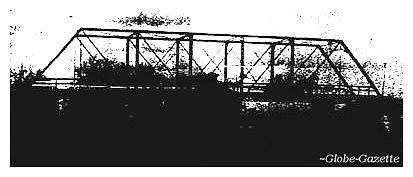
[Section 4, Page 6] From the time this old steel span was built across the Winnebago River on Highway 18 east of Mason City in the late 80's, the bridge over the stream has been known as the Taylor bridge, a name it received from the first settlers who owned the land in that area. Two Taylor brothers, J. P. and Alfred, came to Cerro Gordo County in 1856 from New York state. Alfred purchased the land in the southwest quarter of section 12 in Mason Township, which included the present bridge site. He built a stone house on the knoll just east of the river and south of the highway. This structure remained standing until recently. Early settlers when they came to Mason City to do their trading had to ford the stream and it was not until in the 80's that this steel bridge was erected. It is possible that some type of small wooden structure crossed the stream earlier. The steel bridge stood a little to the south of the present concrete structure, which was built by the city in 1924. Alfred Taylor died in the early 60's and his widow returned to New York. J. P. Taylor, who located on a part of the northeast quarter of section 13 of Mason Township, where he lived until 1869. He then sold his farm and moved to Charles City. Thus these two brothers who lived on the banks of the Winnebago almost 100 years ago gave their name to "Taylor Bridge." NOTE: Alfred Taylor was born in Chenango, New York December 7, 1823, and died September 6, 1876. Alfred's wife, Emiline (Brewer) Taylor, was born in New York state April 11, 1827, and died July 5, 1885, Norwich, New York. They were charter members of Mason City's Methodist Episcopal Church, organized March 7, 1857.
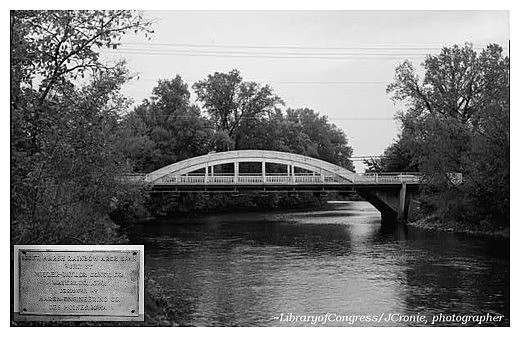
WHERE TAYLORS LIVED
[Section 4, Page 6] This is the J. P. Taylor home southeast of Mason City. He and his brother Alfred Taylor came to Cerro Gordo County in 1856 and it's from them that the Taylor bridge east of Mason City, gets its name.
BICYCLE RACING POPULAR [Section 4, Page 6] Bicycle racing was popular in the olden days. Prizes were given for the best riders in various fields. Clubs flourished, especially among the younger generation.
STUDENTS CARRIED WOOD to FEED FOUR STOVES in SCHOOL [Section 4, Page 6] Despite the comparative magnificence of the old Central School building at the time of its erection in 1874, it still had a primitive heating system. Four box stoves that would admit cord wood sawed in halves provided the warmth. The wood was prepared in the basement and brought to the third floor in the sturdy and willing arms of the boys, who deemed it a privilege rather than a hardship to contribute their vigor to the well-being of their schoolmates. In the execution of these rugged duties it frequently happened that considerable entertainment was either intentionally or non-intentionally forthcoming. The unruly cord wood that would insist upon rolling from their strong arms down an entire flight of stairs to the consternation of the dignified instructors and the delight of the devoted students, broke the monotony of the confining school life.
1886: FARMERS ORGANIZE for FIRE PROTECTION MASON CITY GETS ANOTHER RAILROAD [Section 4, Page 8] In 1886 The Mason City and Fort Dodge Railroad was built from Fort Dodge to Mason City by Hamilton Brown of Boone. This stretch of rails was later [on November 1, 1901] to become a part of the 1,500 mile system of the Chicago Great Western Railway - which stretches like a giant cross from Minneapolis to Kansas City and from Chicago to Omaha. The year 1886 was also an important milestone for the farmers of Cerro Gordo County. That year they banded together and organized the Farmers Mutual Insurance Association to provide protection for fire and lightning losses. Later the association came to handle tornado insurance. The association grew out of the practice of the early settlers to pass the hat to aid farmers who had suffered loss from fire. It provided a more equitable plan whereby all carried the cost of protection for themselves. The first secretary of the association was Deacon J. G. Brown, grandfather of J. G. Brown, present Cerro Gordo County supervisor. The office was in a house in the northeast part of the city near the present Ideal Sand and Gravel Company plant. The business of the association grew rapidly from the start and at present it has $41 million of insurance in force.

1887: FARMERS SHIFT to MOVE CATTLE AS WHEAT YIELDS DROP [Section 4, Page 8] With the coming of the railroads, wheat raising leaped into importance in the Mason City area. For seven fat years enormous yields of from 20 to 40 bushels to the acre were produced. The crop in 1877 was memorable for its yield with 45 and even 50 bushels an acre. It was a year to be remembered. It was nature's last great reward to the toilers on the farms before she started teaching them the necessity of crop rotation and the use of livestock. In 1878 there began a period of famine. The wheat yield that year dropped to 10 bushels an acre. More failures followed with attendant hardships as farmers came to the realization they must turn to other crops, to rotation, to the feeding of livestock and dairying. It took a decade to accomplish any extensive change and by 1887 Cerro Gordo County had become a fairly heavy producer of cattle. During the shift, however, chattel mortgages wiped away farm implements and household goods and even farms were lost. But gradually farmers were convinced and became able to build up their cattle herds. In 1875 there were 5,830 head of cattle in the county. By 1879 the number had increased to 8,456. In 1880 the county produced 36,718 gallons of mil, 418,401 pounds of butter and 8,445 pounds of cheese. The big increase in cattle took place the following few years. By 1884 there were 15,805 head of cattle. By 1887 the number had passed the 20,000 mark and kept increasing rapidly until by the close of the century it had doubled that mark.
Thus it took nearly a generation to complete this revolution of farm operation. By the close of the century corn had become the big crop with oats in second place and very little wheat grown. In describing this change, Arthur Pickford, for many years Globe-Gazette farm editor, in his book, "Westward to Iowa," said: "A change seemed to have come over the summer climate of Iowa. Wheat requires a long, cool ripening period and that is what Iowa had in early days, but when the rush of settlers turned over a million acres of grass into hot stubble or plowed ground, the ripening wheat was cooked and the plant died prematurely. So the spring wheat belt moved north into Minnesota and Iowa became 'the land where the tall corn grows.'" Pickford also stated the exit of wheat was hastened by the appearance of the chinch bug. Grasshoppers also made their devastating incursions in the 70's. The transition to livestock was not without its troubles. There came animal diseases of increasing virulence depleting herds and flocks with no effective system of public control and eradication. This was to come later. The transition from wheat to diversification involved not only problems of production but some acute ones of finance. Farmers from the time they first came were required to pay high rates of interest on borrowed money. High transportation costs, wastes and inefficiencies of the marketing system cut down his income. This led the farmer to organize first in the Grange and later to set up their own marketing system through co-operative elevators. That agrarian revolt was persistent from decade to decade to meet new situations. Farm organization had its beginnings in an Agricultural Society in 1860. This limped along until in 1872 when a reorganization took place under the leadership of George Henderson. Shares in the organization were sold at $10 each. When the articles of incorporation were adopted April 13, 1872, George R. Miller was elected president; Charles W. Tenney, vice president; Thomas G. Emsley, secretary; and Henry Martin, treasurer. Fairground were purchased to the northwest of Mason City and a series of fairs were held for 30 years. Then interest waned, the grounds were sold and the affairs of the association wound up. A move for the new fair association was to get under way after the turn of the century.
COMPANY A, 6th INFANTRY IN 1887

[Section 4, Page 8] From pioneer days Mason City has had guard companies. Shown above is Company A, 6th Infantry, back in 1887. The picture was taken in front of the old Armory situated on 1st and Washington S.W., west of the present fire station. Commanding the organization was Capt. James Rule, politician and banker, as well as military man, shown to the front left. A few years later Rule was a brigadier general, commanding the brigade and I. R. Kirk was company captain. The National Guard continued as an important community activity.
HISTORIC BUILDINGS
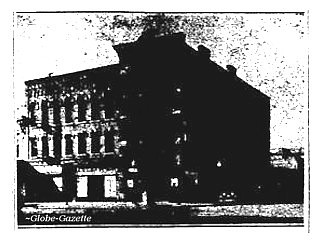
[Section 4, Page 8] These two historic buildings were torn down in 1935 to give way to the Montgomery Ward and Company store. On the corner is the Lloyd and Tuttle hall, scene of early gatherings and entertainments, built in 1870 or 1871. Next to it is the Hoxie building, erected in 1887. The hall on the third floor of the Hoxie building was used by the Masons until their own building was erected in 1895.
1888: IDEA STARTED IN A GRANARY Co-OP ELEVATORS HELP IN FARM MARKETING [Section 4, Page 9] In the fall of 1888, a group of farmers met in a granary near Rockwell and started talking about organizing a co-operative elevator. Farmers felt they were at the mercy of many unscrupulous buyers of grain who took advantage of them in the margin of profit taken and the dockage exacted. They decided the only solution was to have their own marketing organization. Herewith began one of the most interesting dramas in the story of the advance of agricultural industry in this area. A call issued through the Rockwell Phonograph brought farmers in the vicinity of Rockwell together in the town hall Jan. 30, 1889, for the purpose of organizing a co-operative society. The decision of the meeting was to proceed with the organization, which was completed with the election of President Norman Densmore and other officers the following March 2.
Shares were sold at $10 each for the erection of an elevator, corn crib and other buildings. H. I. Smith, president of the First National Bank of Mason City, offered to loan the enterprise $1,000 without interest for one year to get the business started.
This clause formed the keystone of a successful co-operative marketing organization and made the town of Rockwell famous as the mother of the farmer elevator co-operation throughout the Middlewest. Rockwell was also to prove the [illegible] ground for the organization as a state association of co-op elevators. This took place at a meeting in that community Nov. 3, 1904.
The association grew rapidly. A convention was held at Fort Dodge and in 1906, at Mason City. At the Mason City convention a new and powerful voice was heard, which Holman described as: "A feature of this convention was an eloquent address by Ed Dunn of such merit it was ordered published and distributed." The association now entered one of its most dramatic periods. In uniformity with a Senator LaFollett resolution the interstate commerce commission began a series of hearings to investigate the grain elevator business. One of these hearings was held at Des Moines and participated in by the Iowa Co-Op Association. This hearing revealed evidences of collusion between carriers and elevator companies and gave the co-ops opportunity to make a showing of benefits provided their members. Out of it came a tremendous [illegible] for the farmer's cause.
MASON CITY HIGH SCHOOL CADETS in 1888
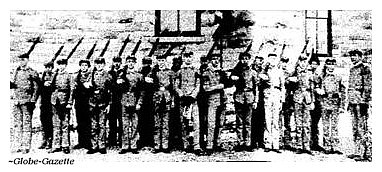
[Section 4, Page 9] Back in about 1888 when drilling and pump-pump-pullaway comprised the only "extra-curricular" activities in the Mason City high school, Capt. Arthur L. Rule commanded these cadets. The 20 of them in the company made up practically then entire membership of boys in the high school in those days. From left are: H. D. Page, George Van Wie, Dr. C. E. Dakin, Hugh H. Shepard, Peter Sweningson, Frank Currie, Ed Wilcox, Bert Hamilton, Clifford Robinson, Frank Renshaw, C. A. Parker, Oscar Swanson, Dr. Will Farrell, Hans Johansen, Archie Dougan, Bert Brock, Harry Dyer, Harry Kellogg, Willis G. C. Bagley and Capt. Rule.
1888 BOYS BAND GIVES CONCERT [Section 4, Page 9] A Junior Cornet Band, made up of boys, was one of Mason City's musical organizations in 1888. A local resident has a copy of the program for a benefit concert given by the band at Parker's Opera House March 1 of that year. The concert consisted of instrumental and vocal solos, instrumental and vocal duets, ladies quartet, male quartet, overtures and select readings "by the leading talent of Mason City." The band made its debut in the "Kid Band March," written expressly for the young players. The bad was made up of 23 members with an average age of 12 years. The list includes names that are still familiar in Mason City: baritone, Walter Beresford; tuba, Burr Keeler; E flat cornets, Cliss Sale, Tom Stinson and Walter Brown; piccolo, Frank Currie; solo alto, Harry Keeler; alto, Clifford Robinson, Clare Kirk and Earl Thompkins; snare drums, Burt Hamilton; B flat cornets, Walter King, Willis Bagley, Fred Harrison, Chan Dakin and Henry Stanbery; tenor, Harry Dyer, Charles Lafferty, Theodore Foster and Vern Kirk; bass drum, Vern Anders; and cymbals, William McIntosh.
CIVIL WAR NEWS SLOW in ARRIVING [Section 4, Page 9] The Civil War was in progress more than a week before Iowa readers were aware of it, according to early day newspapers. It took nine days for the news of the firing on Fort Sumter to reach Mason City.
FIRST PIPE ORGAN IN MASON CITY [Section 4, Page 9] The first pipe organ in Mason City was installed in the initial First Methodist Church which stood on the present site of the Piggly Wiggly store north of Central Park. Prof. L. L. Huntley installed and played the organ. He was a graduate of the Boston Conservatory of Music and was for many years a leading figure in music in the community. Other organists were Mrs. Millie Robinson, wife of M. U. Robinson; Miss Jessie Vermilya (Mrs. Frank Decker); and Mrs. Richard Raw. Many of the early musicians learned to play in this church.
YOUNG BANKERS
[Section 4, Page 9] These three made up the entire force of the First National Bank outside of the officers in 1890 when the picture was taken. From left are: Fred Keeler, later to become head of the Mason City Brick and Tile Company; William Richards, whose father started the packing house business in Mason City and later sold out to Jacob E. Decker and Sons; and Willis G. C. Bagley, later to become president of the bank. At that time Keeler was assistant cashier, while Bagley was bookkeeper and Richards, collection clerk. H. I. Smith was president of the bank and C. H. McNider, cashier.
1889: EARLY COURT SCENES DEPICTED [Section 4, Page 9] It was along in 1889 that a Mason City lawyer defending a criminal case became so incensed at the remarks of the prosecuting attorney that he picked up the bulky Iowa code and was about to hurl it at his opponent. Another lawyer quickly objected to the introduction of the code in evidence in that form as incompetent, irrelevaent and immaterial. The court sustained the objection and quite was restored. This was one of a number of Pickwickian court scenes depicted by John Cliggitt in an early history of the bar. Herbert Quick, who studied in Cliggitt's office, recalled that Atty. Pat Dougherty one day borrowed the office Code of Iowa. When the code was returned it was covered with brown paper stitched within its covers. Cliggitt looked at it curiously. Such meticulous care of a borrowed book was not characteristic of Pat. "Finally," wrote Quick, "we found in it some papers in the case he had been trying. It was a justice court case just over the Minnesota line. Pat had found in the Iowa code some law which fitted his case and covered the book so as to hide the fact that it was not the Code of Minnesota." In writing about the law practice of this era, Cliggitt said: "During all these years of the past, how much of wit, eloquence and argument both prosaic and poetical, has vanished, which might have been saved to amuse and instruct the present and future generations had the phonograph recorded the words, sounds, tones of voice of counsel in their various addresses to judges and juries. "Like Hamlet at the grave of Poor York, one may imagine somewhat of the infinite jests and excellent fancies, flashes of merriment, the quiddits quillets cases and somewhat of tricks of these lawyers dead and living, spoken and done in advocacy of their client's causes, but they cannot now be reproduced in their living reality." There is this story of Col. J. H. McConlogue which always affords a great deal of pleasure. The colonel, a tall, white haired imposing man, was a democrat and had served on the military staff of Gov. Horace Boles, where he received his title. One spring in traveling to Northwood over the old Iowa Central railway he met a young barrister who was highly impressed. Struck by the military title, white hair and commanding presence, the young man asked, "Colonel, did you serve in the Civil or Spanish-American War?" The colonel glowered down at him and replied: "My ____ young many, don't you read your county's history?"
Duncan Rule was defending a woman of certainly uncertain virtue, accused of operating a house of ill fame. The case was presented vigorously by the county attorney with the very best of evidence, it being what might well be termed an open and shut case. In his argument to the jury Duncan quoted from that portion of the Gospel where the woman taken in adultery was brought before Christ. The Scribes and Pharisees when asked what should be her punishment said she should be stoned to death. Christ listened to the argument and with his finger writing in the sand turned to the Scribes and Pharasees and said: "Let him who is without sin cast the first stone." Tears were in the eyes of the jury after his masterly argument and the woman was acquitted.
1890: INTIMATE GLIMPSES OF OLDEN DAYS EARLY NEGROES IN CITY [Section 4, Page 10] EDITOR'S NOTE: Beginning about 1890 Negroes began coming to Mason City to live. The story of the lives of the pioneer Negroes is given in the following excellent article. So that no colored person who moved here since 1900 will assume that he has been overlooked in this little sketch, let me say that I speak of the pioneer Negroes who lived here before that. And ladies, if you do not wish to claim middle age, please do not rush forward to join this parade. One little "Me too" will cause your age to show. When Lewis W. Tyler came to Mason City in the fall of 1891, colored people were scarce, men and women about a dozen. He came to work as a barber for Charles Watson, master barber and proprietor of the largest shop in town. Just a little before Dad arrived the night town marshal was a Negro. Al Lewis, tall, big, very light-skinned. Shades of the FEPC. Is this news to the police force? Mother and I came the following spring from Marshalltown. I am told that when Dad met us at the Iowa Central station, now the M. and St. L., she said, "Lewis, you have moved me to half a dozen towns in the few years we have been married. This is the last move. I'm here to stay." The Tyler family has lived here 60 years.
Charles Watson is the best known colored pioneer of this vicinity. Tall, brown-skinned, rather corpulent, he was very well liked. His best known venture in friendship was his sponsoring of that almost legendary baseball team, "Watson's Colts." Did you ever hear of another local team of that time called "Finnegan's Mules?" In 1892 Watson's shop was beneath the City National Bank. The bank stood where Goodman's Jewelry store is now, and like many buildings of that time was about five steps above the street level. Later Watson changed his place of business several times. The shop had four barber chairs, a shoeshine stand for the porter. Huge mirrors were against the wall and stands for towels and tools were in front of them. In the rear were several small rectangular bathrooms. Back of the shop was a boiler room that provided heat and hot water for the entire building. And, believe it or not, there was still room for a poolhall. During the Spanish War period this boiler also furnished steam to run the presses of the Globe-Gazette whose office was at the rear of the bank. The presses and part of the composing room were in the basement. Peedan and Marine were owner and publisher. I was one of their carriers. The mention of bathrooms in connection with a barbershop may need some explanation for younger folk. Before the turn of the century very few families had bathrooms in the home. So, the head of the family often took his weekly bath at the barbershop while mamma and the children used the kitchen and the laundry tubs. Watson's shop had several tubs. The porter saw that each was clean, drew the water, tested its temperature, provided towels and soap. Also, at times, he washed the customer's back. This generally produced at tip. Any of the barbers if not busy were happy to perform that little task. One time Dad readied a tub for a patron who was especially liked for his generous tips. Everything in readiness. Dad came out of the bathroom and called: "All set, Mr." The gentleman hastened into the bath room quickly undressed and leaped into the water. There was an agonized scream, the man ran into the shop entirely naked - entirely - and commenced to call Dad all the naughty names in a lurid vocabulary. Dad had forgotten to cool that very hot water. At the time Watson employed two colored and two white barbers. He was so democratic he did not need the FEPC [Fair Employment Practices Commission]. William Dotson, the caretaker of the famous Mason City race horse, Storm, was short and dark with a perpetual stoop. I never knew of his driving a race but as a caretaker of horses I am told that he was a master. Bill was proud and inordinately found of clothes and jewelry. In the prime of life he had plenty of both and wore it in profusion. A softer hearted, friendlier man never lived. Anyone with a hard luck story, either bonafide or spurious, could get a loan from him ad they seldom were repaid. Dotson married a Philadelphia woman and was in that city the night Storm burned to death. Bill always felt that had he been here he could have saved Kirk's famous animal. we know that he would have tried desperately. Bill's wife died shortly after their marriage. He was a great lover of dogs and always had one or more. One time a lady had Bill take care of her snow white poodle while she made a visit back East. While the lady was gone someone, a certain druggist was always suspicioned, dyed that white dog a vivid green. Bill went wild but he couldn't remove remove the color, it had to wear off. The best remembered of his own dogs is doubtless the jet black one named Cracker. On any holiday that called for something special in the line of food, like Christmas, Bill even remembered his dog. I met him one Christmas night. He had a paper bag in his hand but wanted to chat so called: "Wait a minute, Tom, until I feed Cracker." The dog was excitedly leaping about. Bill opened the sack and took out a delectable roasted turkey leg and thigh. Then he said softly, "Cracker, I had my Christmas dinner and now here's your Christmas dinner." Horses finally caused Bill's death. His barn caught fire and Bill trying to rescue them was badly burned. That and the exposure was fatal. John Armstrong was perhaps the most powerful Negro physically that lived here in the early days. He was short, brown-skinned, bow-legged and had shoulders that seemed a yard across. He was a good rough and tumble fighter and loved it. In spite of his bulk and strength he was a wonderful barber with a touch as light as the lather one spread on a face. On the back of his head at the base of the hair he had a large scar which he got while living in Nora Springs. One Fourth of July he tried to whip the entire population of that little village. He was doing well until a doctor with the good village at heart, slipped behind John with a dray stake and hit him. That ended the battle and produced the scar. Armstrong moved to Mason City. while working for Watson on another Fourth of July having heard of a man in the neighborhood of Green who was considered invincible, he decided that the man must be whipped. Then, when Watson, understanding the situation, would not advance him the money for a trip to Greene. He walked the 20 miles, was thoroughly trounced by their champion, then he walked the 20 miles back. Later, Armstrong opened a shop of his own on the second floor of the newly built Odd Fellow Building. His barbershop was the first stop on my Globe-Gazette paper route. Armstrong later moved into a building on S. Federal near the bridge. He died some time after ward leaving a widow and one son. The widow moved to Washington, D. C. and remarried. The son lives on the West Coast. Another stop on my paper route was the barbershop of Taylor and Reeler. It was underneath the First National Bank, they opened in 1895. The baths in their shop was for some time operated by a white man named Becker. Lou Taylor was a large, light-complexioned man, married but with no children. After some years he severed connections with the firm and opened a shop in the basement of the Brick and Tile Building. And too, for a while he was in the basement of the Cerro Gordo Hotel, then named the Andersen. After a time he returned to Marshalltown. His health failed and after his death his wife returned to Mason City where she worked as a maid in the Damon and Igou department store until her death. J. D. Reeler was a chiropodist as well as a barber. He owned the shop which with the remodeling of the First National Bank became the nicest shop in town. He sold to James McNamara and opened a chiropodist office in the present [1953] location of Dr. Martin who purchased the business when Mr. Reeler became too sick to continue. The Milwaukee Railroad was responsible for many of the pioneers. Mason City was the terminal for their dining service going west and their sleeping car service going east. The Hotel Stanton provided rooms for these colored men on their layover. When more colored folk came to town those porters, cooks and waiters took rooms in those private homes. And some of those men liked Mason city so well, they moved their families here. W. H. Alexander was the first one that I knew. He was chef on the superintendent's private car. Seeing an opportunity to better himself he quit the road to take a chef's job in the newly opened Hotel Hildreth in Charles City. That was about 1893. He was there for years and died in 1914. His widow died only a few years ago at the age of 93. One daughter survives and lives in Charles City. John L. Hunter with his family came to Mason City in 1895 to be a chef on the Milwaukee. The family had hardly arrived when one of the children died. A few years later Hunter died leaving his widow with six children. She remained in Mason City and provided a home by catering for parties. About 1897 John Carter moved to town. He had lived in Kansas but relatives near here persuaded him to make the change. With him were two sons, Will and Sol, also two daughters, Mrs. John Stephenson and Mrs. William Bradford. John Carter, John and Oliver Stephenson helped lay the sewer and water mains that had to be installed prior to laying of the pavement on Federal, State, Washington and other streets. John Carter worked for the water department for years. His oldest son, Will was custodian at the First National Bank. The younger son, Sol, was custodian in the Central Trust Building where the Penney store is now located. A granddaughter still lives here, a widow, Mrs. Leona Ewing. In those early days the colored people had no church of their own so attended the white churches. Watsons were Baptists. The Reelers and Hunters were Congregational. Tylers attended the Church of Christ. Bill Dotson was Methodist. Yet when the growing Negro population called for a church these pioneers forgot their technical differences in belief, united and started the Union Memorial Methodist Church.
BUILT IN 1890
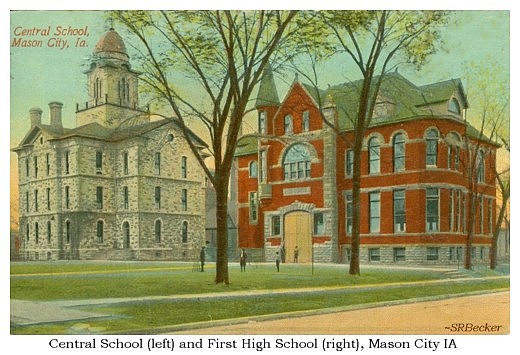
[Section 4, Page 10] Mason City's first high school, the old brick building in the Central School grounds, was erected in 1890.
CAME IN 1892
NOTE: Thomas Charles Tyler was born June 20, 1884, Cedar Rapids, Iowa, son of Lewis W. and Kelsey (Boone) Tyler. He married Grace Stratton in 1909, Mason City. Grace died in 1910. Thomas died September 24, 1961 at the Good Samaritan Home, Mason City. He was interred at Manly, Iowa.
HERBERT QUICK LIVED HERE
NOTE: John "Herbert" Quick was born October 23, 1861, Steamboat Rock, Iowa, the son of Martin (1816-1891) and Margaret (Coleman) Quick (1832-1912), and died May 10, 1925, Columbia, Missouri. He was somewhat crippled at an early age by polio. Quick married Ella D. Corey. He served on the Federal Farm Loan Bureau in Washington, D.C. from 1916 to 1919. Among various poems and articles, he authored eighteen books, which include "Vandemark's Folly" (1922), "The Hawkeye" (1923), "The Invisible Woman" (1924) and "One Man's Life" (1925). His autobiography, "One Man's Life" was published shortly before his death in 1925. SOURCE: exploreiowageology.org/Herbert_Quick.php
1891: HENKEL STARTS BUILDING; CHRISTIAN CHURCH ORGANIZED
It was in 1891 that the First Christian Congregation was organized in Mason City, which then had just passed the 4,000 mark in population. The year 1891 saw the organization of the famous Mason City Turf Club, headed by the dynamic James Rule. Mason City was just starting to awaken to the possibilities of large industries here. Henkel's entry into the building business was founded on a trade he learned in his native Hammer, Germany, that of bricklaying. He came to Mason City from Wisconsin. In the early years Henkel was associated with a number of other contractors. With Emil Tobsing and George Bruns he erected the St. Joseph's Catholic Church. After this Henkel then began a series of construction projects at Jacob E. Decker and Sons as that corporation expanded its operations with almost magic rapidity. He was associated with Bruns in constructing a number of concrete bridges, then came the building of the Chapman furniture store (Davidsons), the Jefferson School, the Pennsylvania Avenue bridge, the bridge at First S.W., and the bridge over Willow Creek in Wildwood. In 1920 Henkel and his son, Carl, entered the pavement construction field. Their first pavement was the stretch between Mason City and the Floyd County line. The following year the pavement was extended through Britt to the west Hancock County line. They then transferred their operations to Wisconsin and Illinois. After the heaving paving program was over the Henkels turned back to the general construction field, in which they have been engaged since.
NOTE: William F. Henkel was born in 1871, and died November 19, 1958. His wife Ida
Helena Henkel was born in 1877, and died May 20, 1960. Carl A. Henkel was born November 4, 1894, and
died October 8, 1974. Clara B. Henkel was born April 21, 1884, and died January 16, 1973. They were interred at Memorial Park, Mason City.
PIONEER KINDERGARTEN
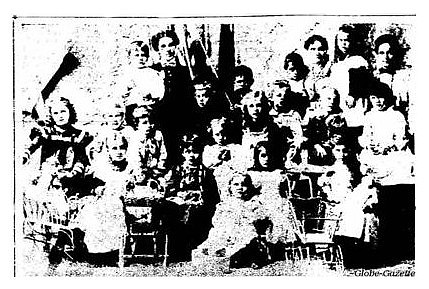
[Section 4, Page 11] Back in the early 1890's, Mrs. Rosalie Willson, mother of Dixie, Cedric and Meredith Willson, operated a Kindergarten in Mason City. She is shown above with her class and two assistants, June Huntley, left, and Belle Reiniger Moll, sister of Mrs. Willson, right. Dixie Willson is seen with her doll and buggy at the extreme left of the picture. Others identified by local residents include Hazel Ramsey, between buggies; Justus Moll, to left of June Huntley; Cedric Willson, left of Mrs. Willson; Mariam Winter, right of second buggy; Helen Winter, below Belle Moll; Glen Konvalinka, holding flag; Gladys Merrill, below Konvalinka; Ralph Waughtal, below Justus Moll. This kindergarten got wide publicity over the country, because this phase of education was new at that time. The above picture even appeared in a Chicago daily newspaper.
NOTE: Rosalie Eliza "Rose" (Reiniger) Willson was born in Brighton, Illinois, March 17, 1860,
and died September 24, 1941, Tiffin, Ohio. She was the second of seven children born to Gustavus George
and Eliza Aimsworth (Meachem) Reiniger. She married on August 28, 1889, Brighton, Illinois, John David Willson and they were the parents of four children,
Dixie Lucille Reinger Willson, Maurine Willson who died at six months of age, John "Cedric" Willson and
Robert "Meredith" Willson. She was a piano teacher. Rosalie and John later divorced.
1892: YMCA ORGANIZED in MASON CITY [Section 4, Page 11] It was in the evening of May 6, 1892, that a group of young men gathered in the office of Atty. J. J. Clark and organized the Young Men's Christian Association in Mason City. Clark was named president of the association and served as one of its leading figures until his death in 1937. C. H. McNider, who later was to head the building program, was named treasurer and J. C. McNeil, secretary. Named as board members were: E. P. Fox, Dr. E. McEwen, E. E. Stephenson, G. F. Hull, R. Bird, and H. A. Dyer. At its first annual meeting Jan. 14, 1894, the association had a membership of 156. At a board meeting April 1, 1901, a committee was named to investigate the possibility for a new building. But the YMCA wasn't to acquire a building until a quarter of a century later.
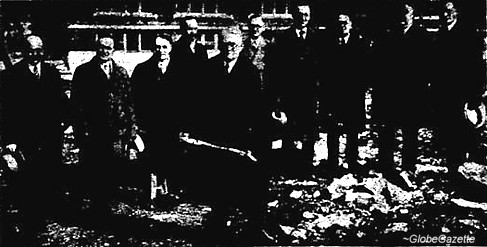
L-R: C. H. McNider, George S. Marty, Dr. George M. Crabb, W. S. Wilcox, Henry J. Steinberg, C. G. Maudsley, William H. Hathorn, J. A. Van Ness, Frank J. Hanlon, secretary C. G. Gilman The YMCA Building was dedicated debt-free December 11, 1927.
The year 1892 was an important one in Mason City's industrial expansion, which was now beginning to get underway. That year the Mason City Brick and Tile Company, which had been started in 1884, was incorporated, with O. T. Denison soon afterward becoming the president of the rapidly growing company. This year also saw the entry of the Currie family into the hardware business. That year C. Currie and his son, Frank R. Currie, purchased a third share of the stock of Daggett and Schwie.
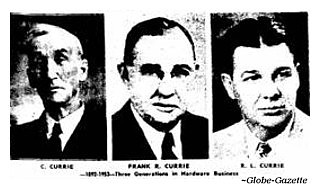
In 1895 the hardware store and tin shop was taken over in its entirety by C. Currie and son and was operated under the name of Frank R. Currie. Next the firm was incorporated under the name of the Currie Hardware Company, with C. Currie as president and Frank R. Currie, vice president. For many years the store occupied the site of the north half of the present Eaton store, but after the fire that destroyed the building in November, 1937, moved to the present [1953] location on East State. R. L. Currie, the third generation of the family in the business, is now [1953] active in the management of the store. NOTE: C. (Corey) Currie, son of James and Mary Maria (Ferris) Currie)
was born in Whitby near Toronto, Canada July 16, 1847, and died in 1942. He married in 1871 Louisa Harriet (Bond) Currie, was born September 29, 1848,
Green Lake County, Wisconsin, and died in 1934, Mason City. Originally, the Curries lived near Titonka, Iowa,
where they farmed and Corey taught school. They moved to Mason City in 1880 where Corey worked as a fireman and
engineer for the Milwaukee Railroad for three years. He operated a restaurant in downtown Mason City from
1884 to 1895. They were interred at Elmwood-St. Joseph Cemetery.
NAME CERRO GORDO for BATTLE in MEXICAN WAR [Section 4, Page 11] If Gen. Scott had lost a certain battle during the Mexican War to Dictator Antonia Lopez de Santa Anna (in person), Cerro Gordo County would not be Cerro Gordo. The third general assembly of Iowa, convening at Iowa City Feb. 5, 1851, gave Cerro Gordo County its present name in honor of Gen. Scott's decisive victory over the Mexican dictator at Cerro Gordo mountain pass in Mexico.
ROMANCE in NAMING of NORA SPRINGS [Section 4, Page 11] Romance has often entered into the names of Iowa towns, Alva Johnson wrote in a recent issue of Annals of Iowa, a publication of the Iowa State Department of History and Archives. "Nora Springs," he ways, "was named by a young engineer who came out into Iowa in 1837. His job was to survey land and plot new towns for this area. He'd been carrying the thoughts of a pretty girl around in his mind, so, when he found a town he liked he wanted to name it for her. "To be sure, the town had a name, the citizens called it Woodstock. But Woodstock, the young surveyor said, didn't mean anything. If they'd call it Nora Springs, that would always stand for the beautiful girl he loved. The surveyor must have been a nice young man and a good persuader, for the citizens of Woodstock did just hat. They changed the name of their town to Nora Springs. "Of course, the engineer and his bride were supposed to come back and make their home there. When he went for her, the girl had changed her mind. The young man couldn't face it,so he moved off to another county. But there stands Nora Springs, a monument to a romantic young man and a changeable girl." Other neighboring communities also have interesting histories that are a part of the drama of the settlement and development of this area.
1893: DVORAK in IOWA - WORLD NOTED COMPOSER at SPILLVILLE
Just how much Mason Cityans at that time knew about the visit of the great composer isn't known. But one thing is certain and that is that North Iowans later came to treasure the incident in the life of this section of the state. Dvorak, accompanied by his family and his American assistant, J. J. Kovarik, a native of Spillville, came to New York as director of the National Conservatory of Music in the fall of 1892. Here it was his purpose to develop for America a school of music that would be typical of American life and ideals as the German, Russian and Italian schools are expressive of their distinctive national traits. At the same time, inspired by his trip and arrival in America, the composer took up the orchestral score, stated in his native land, of the cantata of the "American Flag," Upon the completion of this score, Dr. Dvorak began sketching the now famous "New World Symphony." As the spring of 1893 approached Dvorak wanted more and more to escape from the noisy city, where he found he had little time for composing. He was anxious to work on some new music he had in mind. Kovarik suggested that Dvorak accompany him to Iowa. Kovarik had grown up in Spillville, where his early musical ability led his father to send him to Prague that he might study under Dvorak. Upon his arrival in New York with his master, he asked permission to go at once to visit his parents, but Dvorak had insisted he wait until spring. Now the pupil sought to accomplish two things by having his master visit his home village. Dvorak would get the rest he needed and Kovarik would visit his parents. So it was that a lovely day in June saw Antonin Dvorak, his wife, their six children, a sister, a maid and his assistant, alight from the train at Calmar, 11 miles from Spillville. The idyllic conditions at Spillville seemed to provide the very incentive that was needed, for Dvorak began composing immediately. Within three days he had sketched his "String Quartet in F Major," Opus 96, and at the end of 12 days it was finished - a very unusual achievement. The "New World Symphony" was still in manuscript form when he came to Spillville. To supply duplicates for publishers, Kovarik made several additional copies. He called the composer's attention to the fact that trombone parts had not been placed in the last movement of the symphony so Dvorak set to work. This was probably the only revision he made in the symphony while he was in Iowa. No sooner had the "Quartet in F Major" been finished then Dvorak began composing other chamber music. There is no evidence to show just when the "String Quintet in E Flat," Opus 97, was started, but he finished it in August. The third movement, "theme with variations," was originally intended as a new tune for the hymn, "America." But Dvorak changed his mind and used the air for this wonderful set of variations. Progress on the "Quintet" was interrupted for a week in early August when Dvorak went to Chicago to visit the Columbia Exposition and to conduct the Theodore Thomas Orchestra on Bohemian Day at the World's Fair. A week later, when the "Quintet" was finished he made a trip to Omaha and Minneapolis. He especially wanted to see Minnehaha Falls. As he stood at the foot of the falls and looked up at the beautiful cataract he caught the inspiration for a new melody. Turning to his assistant he asked for some manuscript paper. But Kovarik had none with him, so Dvorak took his pencil and made some notes on his cuff. On returning to Iowa he used this theme in the second movement of his Sonatina for violin and piano, Opus 100. This movement as rearranged by Fritz Kreisler is well known as the "Indian Lament." It is natural to suppose that his intervening works, Opuses 98 and 99, were written in Iowa, but nobody knows just when they were composed. Dvorak's departure from Iowa was precipitated by his eldest daughter. Unknown to her parents she had become infatuated with a young man in Spillville. According to tradition, their elopement was intercepted and so ended the youthful romance. When "Papa" Dvorak learned of the affair he was so incensed that he ordered the family to pack up immediately and they all left for New York the next day. The visit of the great composer to Iowa was nearly forgotten when in 1922 at the annual meeting of the Iowa Conservation Association, Mrs. Louis B. Schmidt, then chairman of the Historic Spots Committee and president of the Iowa Federation of Music Clubs, proposed the commemoration of the episode. The result was that the memorial, which stands on the banks of the Little Turkey River, was dedicated on Sept. 28, 1935. On the face of the monument is carved the name of a Dvorak masterpiece and around the bottom is a list of the compositions upon which he worked while in Iowa.

TIFFANY GROCERY
[Section 4, Page 12] The picture, taken about 1893, shows D. M. Tiffany Grocery, which stood on the present [1953] site of Eaton's, 9 N. Federal. In the doorway are D. M. Tiffany, the proprietor, right, and Frank Miller, clerk. Miller later served on the board of supervisors. NOTE: D. M. Tiffany was born February 1, 1833, and died March 13, 1912. Addie R. Tiffany, his wife, was born February 13, 1843, and died February 24, 1931. They were interred at Elmwood-St. Joseph Cemetery.
1894: "RAINMAKERS" END DROUGHT [Section 4, Page 12] Mason City's many triumphs in the field of band music didn't come over night. Old timers have for decades talked about the famous "Rainmakers' Band" that had its first beginning in 1894 and was at least in part responsible for the development of interest in band music. The year 1894 also recorded other events. It was that year that the cornerstone was laid for the Methodist Church on Washington and 2nd N.W. The ceremony was in charge of Presiding Elder J. C. Grippen. It was in 1894 that the Glanville Dry Goods store was started by T. R. Glanville, who eight years later purchased the interest of his partner, John D. Fiddick. The same year he constructed the building that has housed the Glanville store and its successors to the present.
In 1927 when O. A. Merkel purchased the controlling interest in the store he was joined by another brother, William P. Merkel, and the name of the store was changed to the Merkel Company. Upon the retirement of O. A. Merkel, the store was sold to the present [1953] owner, Alden's Inc. NOTE: Carl J. Merkel was born in 1891, and died in 1965, interment at Elmwood-St. Joseph Cemetery. Getting back to the "Rainmakers' Band," many have wondered how the organization got its name. Thereby hangs this tale: Back in 1894 some 20 young men who were weary of the strenuous life in a city of 4,000, planned a camping trip to Clear Lake, to last for several weeks. The site selected was Mars Hill, a few hundred feet north of the old Oaks Hotel in the month of September. Upon their arrival at the lake it was discovered that nearly every one present played some band instrument so it was inevitable that a band be organized. When the instruments had been sent for H. L. Smith, then president of the First National bank, was elected president and Harry Keeler director. The first concert was given on the lake shore amid the admiring stares of the 20 odd young women who were camping a short distance away. The season had been a dry one and all the farmers were praying for rain before the end of the month. Whether out of displeasure, for the only unholy noise and discord of the band or from delight in the soothing harmonies one will never know, but the heavens let loose the floods and it rained continuously for two days. The long drought was broken and from that day the campers were dubbed "The Rainmakers." Many tales are told of the crate that they kept in their camp. When any of them stayed out with the girls who camped nearby after 11 o'clock he was rolled down the hill in the crate by his companions. W. S. Wilcox once said he was never in the crate because he always went back to the camp unobtrusively, and Harry Page of the Page Lumber Company confessed to being out after hours but on that night he stayed until 1 o'clock to escape punishment. After the return of the campers to Mason City the band gave several concerts and was known as the "Rainmakers' Band" for several years, and later became the Mason City official band. Harry Keeler remained director of the band, although he was of such tender years his name does not appear in the telephone directory of 1894, because he was the only one who could play solo cornet.
1895: OUTING CLUB ORGANIZED at LAKE
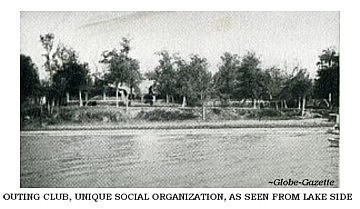
[Section 4, Page 12] That unique and successful social organization, the Outing Club, was organized at Clear Lake in 1895. Families began living in the cottages of the large rambling building on the east shore of Clear Lake in 1897. The rules that were adopted then for a type of community living have prevailed since. For instance, after many years of debate at the directors' meetings, the board finally decided in 1934 to permit smoking in the community dining room. Families occupying the cottages own them and pay dues annually for upkeep of grounds and equipment. The Outing Club is sort of a family tree. The year 1952 found many grandmothers returning with their children and grandchildren to the same place they spent many happy childhood days. Club members were delighted last summer when a fifth generation visited the club. She was Dororthy Inglis Losee, Artesia, N. M., who is a great, great granddaughter of the late N. A. Inglis, Hampton, charter members. In a history of the club by J. W. Irons, secretary since 1917, it is pointed out that 34 of the cottages were built at an original cost of $155 each. In the club's early days an adult could eat at the community dining room for $3 a week and children for $1.50. The dining room was continually in debt, however, but no one seemed to mind. Early in the club's history members began acquiring adjoining cottages, taking down partitions and making them doubles also, adding an upstairs now and then. With increasingly larger numbers of grandchildren this custom has prevailed to the present day. Since the war there has been a regular invasion of third and fourth generation Outing Clubers, prompting the observation that the club appears destined to perpetuate itself indefinitely. The year 1895 is important for another beginning, that of the Western Electric Telephone Company, which was started in Britt that year with the object of serving the Britt area. The system spread to cover all northwest Iowa, and in time the offices of the company were moved to Mason City. The late B. C. Way of Mason City was one of the leading figures in the company, which later became part of the Northwestern Bell System.
1896: BAPTIST CHURCH HERE DEDICATED Minister Risked Life to Save Pipe Organ
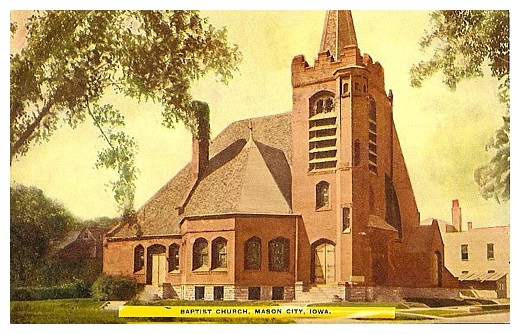
[Section 4, Page 13] On May 10, 1896, dedication of the present First Baptist Church, State and Pennsylvania, took place with Dr. C. H. Strickland, prominent minister of that denomination in Sioux City, giving the sermon. The keys of the building were turned over to the chairman of the board of trustees by John D. Glass, chairman of the building committee, who reported the structure has cost $18,200. The new church took the place of the original First Baptist Church erected on the same site in 1876 at a cost of $4,050. At that time most of the membership was from the country so sheds were constructed beside the property to shelter the horses during services. This church was destroyed by fire on Feb. 8, 1895. The volunteer fire department worked for hours to stop the flames. The water froze on the roof of the building and during the fire one of the volunteer firemen, Scott Stilson, slipped from the roof, breaking his leg. Fortunately for the church, the Rev. Frank C. Wilcox, then pastor of the First Congregational church, had worked with the mechanic who installed the pipe organ, thus becoming familiar with the organ construction. At great personal risk he brought out the reeds and pipes of the Baptist organ and carefully arranged them so that it was possible to use parts of the old organ in the new church. In 1913 the church got its present organ. The large bell, which had summoned Bapists to their house of worship for 20 years, was saved and still hangs in the tower of the present building. Some of the pews were rescued and some of them are still seen as lawn seats about the city. Shortly after the destruction of the old frame building, the congregation made plans for the new edifice. Besides Glass, J. G. (Deacon) Brown, J. S. Wheeler and William Barton were appointed on the building committee. They let the contract for the building to Farrell, White and Rye. The cornerstone, from Randall's quarry, was laid Aug. 29, 1895. Among the fund raising activities for the building was a three day carnival in the old armory. Deacon Brown had an exhibit of antiques, old guns, powderhorns and similar articles. Mrs. John D. Glass was rigged up as a gypsy fortune teller. Fire severely damaged the present structure in the fall of 1927 and was restored at a cost of $15,000 - almost as much as the original cost of the building.
The year 1896 was an important one to Mason City. It was in the summer of that year that W. E. Brice and Lew Ong came to Mason City and started making plans for the construction of the Mason City and Clear Lake Railroad. The Mason City Manufacturing Company, makers of sash, doors and moldings, started in 1896, employing some 30 men. The company made a specialty of veneered doors which were made in large quantities. Bank and office fixtures also were turned out. Robert Ramsay was president and A. H. Ikenberry secretary and manager.
YOUNG BUSINESS MEN in 1896
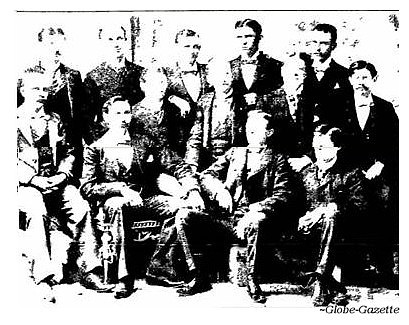
[Section 4, Page 13] From left in this picture of Mason City's young business men in 1896 are: Elmer Pratt, Lee Bailey, Frank Chambers and Carl A. Parker; 2nd row: Harry Page, Dr. J. E. Stinehart, Charles Cole and W. H. Potts; 3rd row, Dr. Frank W. Murphy, Guerdon Vermilya, Chester T. Dike, Will Richards and William Sawyer.
1897: ELKS LODGE ORGANIZED
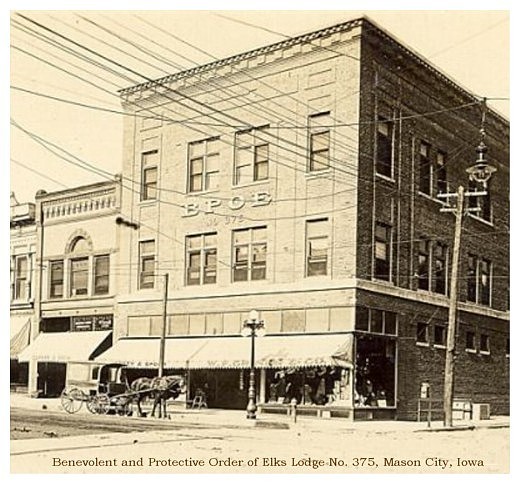
[Section 4, Page 13] Mason City Lodge No. 375 Benevolent and Protective Order of Elks was organized in 1897 with C. H. McNider, Sam Hoyt and Sam White the leading personalities in the project. C. H. McNider was elected as the first exalted ruler. One of the first significant projects staged by the lodge was a street fair held Oct. 3 to 6, 1899. Each of the merchants had a booth in the street at which they served or sold some specialty. H. E. Francisco, who operated a mill at Portland at the time, served dollar sized pancakes from a miniature log cabin. On the north and south sides of Central Park were platforms on which special acts of entertainment were presented. The happy couple was Della Ruth and Leonard Ewers, who received something like $300 in furniture. A huge crowd that flowed into the four of the intersecting streets watched the ceremony. The Elks held their first meetings in a hall situated where the Brick and Tile Building now stands. It then acquired the lots at 122 North Federal from E. C. Demming and F. C. Rate and B. L. Stratton constructed the building. The charter members of the lodge were C. E. Hiam, C. A. Anderson, F. A. Gutterson, R. E. Smith, W. C. Agar, W. C. Clark, H. W. Smith, W. E. Randall, T. H. Beacom, A. A. Crossley, George R. Smith, W. D. Allen, Mc. McKeever, R. M. Calkins, G. S. Gilbertson, C. J. Thompson, O. A. Olson, H. M. Hanson, Clifford P. Smith, G. G. Lincoln, H. I. Smith, George Campbell, G. W. Jones, C. A. Cosgrave, F. E. Keeler, Theodore S. Hines, S. D. Balch, W. G. Martin, C. H. McNider, O. F. Felton, C. M. C. Stewart, C. E. Haynes, Scott S. Stilson, John W. ___ Shea, W. McMorrow, Samuel White, G. E. Wallace, G. A. Emery, W. E. Miller, A. H. Gale, George W. Brett, E. F. White, W. L. Sterns, C. A. Cadwell, S. M. Hoyt, E. O. Mundy, George Warren and C. H. Capron. Following are the past exalted rulers:
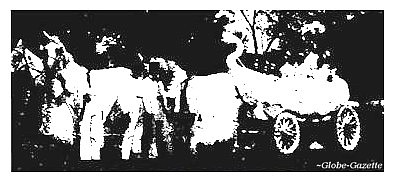
BEFORE THEY WENT TO WAR
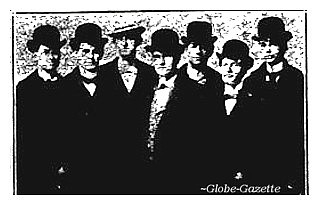
[Section 4, Page 13] This is a picture of the Mason City Bachelors Club, taken the Sunday before five of the members left to enter the service in the Spanish-American War. From left are: Reuben Senior, George Thompson, E. W. Clark, now chairman of the board of the United Home Bank and Trust Company; Ford Tenure, Art White, Chan Smith and Carl Virgil.
POLICEMAN in 1897
[Section 4, Page 15] Mason City policemen wore helmets in 1897, as is evident from this picture of Louis M. Coe, member of the force at that time. NOTE: Louis M. Coe was born December 24, 1877, the son of Joseph Albert and Mathilda R. (Young) Coe. He later was a locomotive engineer in Mason City. He died at the age of 81 years December 27, 1958, and was interred at Memorial Park Cemetery, Mason City.
1898: 100 MASON CITYANS ENTER WAR WITH SPAIN [Section 4, Page 13] When President McKinley on April 23, 1989, issued a call for 125,000 volunteers for the war with Spain, a million men volunteered, among them approximately 100 men from Mason City. Most of the Mason Cityans went as member of A company of the 3rd Iowa Regiment. The nucleus of the group was a national guard company that had served the city and the state for 25 years. It was organized in 1873 as the Ellsworth [illegible]aves with 43 men. The company was afterwards re-organized and became a part of the regular militia of the state as Company H, 6th Regiment, I.N.G. The company was first called out in the summer of 1877, when it was ordered to Plymouth to protect the people of that town against a gang of 275 tramps that had come down on a train from Austin [MN]. Some time later the company was changed from H to A of the 6th Regiment. In 1878 the company acquired an armory on the present [1953] Cerro Gordo Hotel site. In 1894 the company was again called into service, this time to Sioux City to restore order during a strike. At the outbreak of the Spanish-American war, the company with additional volunteers, was ordered to a training camp at Chickamauga, Ga. where it remained until the close of the war. The company was mustered in May 25, 1898, and mustered out the following Oct. 30. The officers of the company were Capt. _. L. Sorter, 1st Lt. Lee Long and 2nd Lt. H. E. Dyer. C. L. Nutting was first sergeant, E. W. Clark, _. S. Rankin and F. P. Tenure, sergeants, and Starr Parker, the bugler. After being mustered out the company was again reorganized as a unit in the National Guard. The year 1898 saw the beginning of the Jewish community in Mason City. That year Mier Wolf and his family moved here from Cedar Rapids, the first Jewish family to live here. The Wolfs were followed in 1902 by other Jewish families and that year Rabbi Isaac Schultz of Chicago came to Mason City as the first spiritual leader of the Jewish community.
PIONEER NURSE
[Section 4, Page 13] One of the pioneer nurses in Mason City was Miss Eva Gibbs. She came to Mason City shortly after being graduated from Northwestern Hospital of Minneapolis in 1898. She was for many years overseer of the poor in Cerro Gordo County.
1899: MURDER TRIAL STIRS MASON CITY [Section 4, Page 14] One of the most sensational murder trials in Mason City's history - the State of Iowa vs. Lottie Hughes - opened Jan. 10, 1899, before Judge John Collins Sherwin. W. F. Muse and Dave Conroy had just purchased the Mason City Globe-Gazette, which ran columns on the trial as one sensational bit of testimony followed another. Mason City that year was at the beginning of a period of industrial growth. The year 1899 brought Jacob E. Decker and his son, Jay, here to purchase the packing plant that now bears their name. It was in 1899 that W. E. Gildner purchased the J. H. Mitchell clothing store in Nora Springs, where he had gone to work two years before. He took his younger brother, J. H. Gildner, with him and thus formed the Gildner Brothers Company, and the beginning of the organization that now has 16 stores. Two years after he purchased his first store, W. E. Gildner left his brother in charge of the Nora Springs store while he went to Manchester to open another establishment. The third venture in the expansion program was the opening of the Mason City store five years later. L. S. Thompson in 1899 started the grocery business that for many years was the Thompson-O'Neil Company, recently purchased by H. S. Marshall and Gerald Chute. But in those early weeks of 1899 the Hughes murder trial overshadowed all other events. Mrs. Hughes, 32 years of age, beautiful and popular, was charged with the murder of her husband, Edward D. Hughes, in April 1898. The state charged that on that day as the family sat down for the evening meal, Ed Hughes complained of not feeling well and his wife got him a dose of salts. Hughes took the medicine and soon afterwards complained of acute pain. he arose from the table, staggered, fell and soon afterwards died. The report was current at the time that death was caused by heart disease.
The sudden death was soon forgotten by the public until the following June when it was learned the body of Ed Hughes had been exhumed at the insistence of the man's father, Patrick Hughes, and the stomach sent to an expert in Chicago who reported the presence of strychnine in sufficient quantity to produce death. In the trial an attempt was made to show the pretty wife had been intimate with a young man [Jesse U. Goude] who had been a frequent visitor at the home. After a sensational trial, which lasted for weeks, the jury found Lottie Hughes not guilty. By this time the county had had only three murder cases and in each one a woman was the defendant. In the late 70's a Mrs. Clayton was charged with being an accessory to a Dr. Winthrup in the crime of abortion on her daughter. She was found not guilty. Dr. Winthrup was tried in Floyd County on a change of venue and found guilty, but the verdict was set aside by the supreme court. About 10 years before the Hughes case, a Mrs. H. E. Brown of Grant township was charged with poisoning her family with arsenic. The father-in-law and one child died. The husband and one child escaped. The stomachs of the deceased were sent to Chicago to be examined by the same chemist, Walter S. Haines, who figured in the Hughes case. The trial caused great excitement, but Mrs. Brown was found not guilty. NOTE: Edward D. "Ed" Hughes was born November 27, 1863, the son of Patrick H. "Pat" and Marilda (Owen) Hughes, and died April 17, 1898, interment made at Elmwood-St. Joseph Cemetery. He owned a plumbing business on Main Street, Mason City at the time of his death. Lottie M. (Thomas) Hughes, born in 1863, was the daughter of Alonzo and Elizabeth (Converse) Thomas, her father a prominent stockman. Lottie and Ed were married in October of 1887 and had two sons: Edward D. Hughes, Jr., born November 27, 1883, and died April 17, 1898, and Vernal R. "Vern" Hughes who was born November 11, 1887, and died November 7, 1919, interment at Elmwood-St. Joseph Cemetery. He shares a headstone with his father. After the trial Lottie and Vern resided with her parents. Jesse U. Goude, born March 12, 1877 at Nora Springs, married Stella Ann McCullugh on March 25, 1903 in Mason City, and died in Eugene, Oregon, on February 4, 1950 at the age of 72 years. Lottie's fate is unknown.
FIRST HORSE DRAWN FIRE WAGON
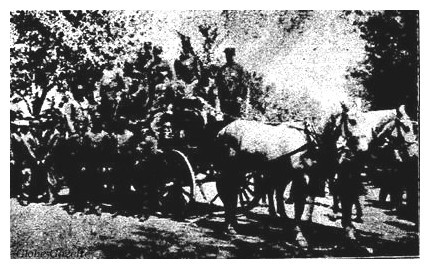
[Section 4, Page 14] Shown is the Mason City fire department of 1895 with the first horse-drawn fire wagon owned by the city and the famous horses, Tom and Jerry. With driver, Henry Quinn, is seated Warren Clark, the chief. To the right of the chief is Dick Davey and Hugh Davey, H. Simpkins and Mark Bradley. The department at that time had 21 men, all volunteers. NOTE: Henry Quinn was born August 24, 1865, and died November 14, 1919. Richard "Dick" Davey was born in 1853, and died in 1924. Hugh Davey was born in 1870, and died in 1936. M. M. Bradley was born in 1855, and died in 1918. They were interred at Elmwood-St. Joseph Cemetery.
S. B. WAUGHTAL WAS CEMETERY SUBSCRIBER [Section 4, Page 14] Among the first to subscribe for a share of stock in the newly formed Mason City Cemetery Association, now Elmwood, was S. B. Waughtal, the village blacksmith. The cemetery association still has the original certificate in which states: "This is to certify that S. B. Waughtal has duly subscribed one share of stock in the Mason City Cemetery Association entitling him to one vote. June 27, 1867." NOTE: Samuel Baughman Waughtal was born in Smithfield, Illinois, January 5, 1834, and died in Mason City September 25, 1897. His wife, Sarah Ann (Couey) Waughtal, was born January 10, 1839, Randolph, Iowa, and died February 1, 1913, Mason City. Their son, Fred A. Waughtal, was born January 12, 1867, and died June 26, 1890. Their daughter, Sadie E. Waughtal, was born July 16, 1871, and died October 25, 1896. They were interred at Elmwood-St. Joseph Cemetery.
FIRST TELEPHONE OPERATOR
[Section 4, Page 14] Sadie Reineke was the first telephone operator in Mason City, starting her work about 1885. One of her jobs was to call each of the five subscribers each morning and when they answered she would say, "Morning test, ring off."
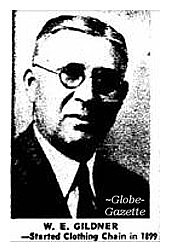
[Section 4, Page 14] Started Clothing Chain in 1899. NOTE: William E. Gildner was born January 6, 1877, and died at the age of 95 years in April of 1872.
1900: MASON CITY'S FIRST FOOTBALL TEAM PLACED EMPHASIS ON WEIGHT, PADDING [Section 4, Page 14] Among the keepsakes of the Mason City High School is a picture of the first football team. It was taken in 1900, the year Mason city first tackled the modern grid game. The picture shows the players padded from head to foot. In those days weight was power and speed was considered an unessential. Charles H. Barber was captain and Fred Duffield, later general manager of Jacob E. Decker and Sons, was a member of the team. The schedule usually consisted of games with Clear Lake, Garner, New Hampton, Blue Earth and Austin. The Blue Earth game was the big game of the season and both teams primed all season for it.
Players had to provide their own suits and equipment and often their own traveling expenses. There was no gym, no shower baths. Difficulty was even experienced in finding dressing rooms for the players. They either dressed in the basement or attic of the old red brick high school or in the basement of the old Central School. The captain acted as coach and manager. Occasionally some local college graduate would offer his assistance. Since the team was required to make only five yards in the downs instead of the present ten yards in four downs, the mass play was practically the only method of advance. The forward pass was unknown and the heavy pads made long runs impractical. The flying or "revolving wedge" was a favorite method of advancing the ball. On this play the entire team milled about the man carrying the ball, protecting him on all sides. J. C. Stoddard captained the team of 1901. There followed then three years of inactivity as the game had not proved popular. In 1905 a team was again put into the field with L. L. Stoddard as captain. The new high school, now called the Lincoln, had just been completed and a new interest developed in all athletics.
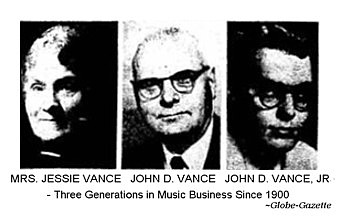
Other important events also took place in 1900. It was that year that Mrs. Jessie Vance started the music business which still bears that name. For many years the store was on the Century Annex on Delaware S. E. On Jan. 7, 1912, fire destroyed the building and the store was moved to a Federal Avenue site and in 1919 to its present [1953] location. Mrs. Vance was active manager of the company until 1925 when her son, John D. Vance, who had started with the firm in 1911, became the manager. John D. Vance, Jr. joined the firm in 1950 and on his return from service in 1952 became an officer in the company. The officers are: John D. Vance, president; John D. Vance, Jr., vice president; and Mrs. Nora Vance, secretary. NOTE: Jessie Vance was born in 1863, and died in 1940. Her husband, David Guile Vance, was born in 1862, and died in 1933. John David Vance, Sr. was born June 17, 1889, served as a Pharmacist's Mate in the U.S. Navy during World War I, and died November 5, 1963. John married Nora Marie (Angell) Vance Stuart July 5, 1921, Des Moines, Iowa. Nora was born April 27, 1899, Swaledale, Iowa, the daughter of Byron and Gertrude Margaret Angell, and died November 3, 1990, Mason City. Nora, whose gravestone has the epitaph "Mrs. Community Concert," married second December 20, 1970 Leroy Stuart (1888 - 1972). They were interred at Elmwood-St. Joseph Cemetery. F. J. Toland, who owned a chain of private business schools came to Mason City in 1900 and opened the business school which in 1908 was purchased by Ward Hamilton and became the Hamilton School of Commerce. Hamilton was employed by the school as fieldman in 1904 and the following year became an instructor. NOTE: Hamilton School is the oldest continuously operating college in the State of Iowa specializing in business education. The college was purchased by Quest Education Corporation in 1998, and then acquired by Kaplan Inc. in 2000. Operating as Kaplan University, there are seven campuses located in Iowa and Nebraska.
THE ORIGINAL MOHAWKS
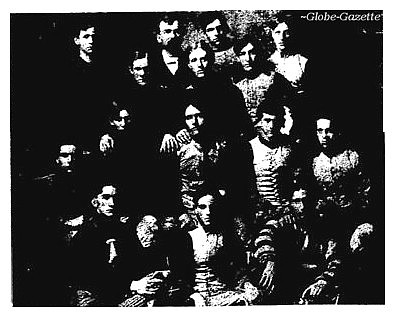
[Section 4, Page 14] Everything has to have a beginning and in the football team shown above was the first to perform for the Mason City High School, in 1900. From the left the players are- First row: Fred Duffield, Frank Roach and Fred Pfahler; Second row: Sidney Long, J. C. Stoddard, Charles H. Barber (captain), Willis Dimmick and Clare Hicks; Third row: Mose Squier, Orin Simpkins and Albert Anderson; Top row: Charles Roberts, Supt. A. R. Sale, Ralph Richardson and Bert Cummings.
1901: PASTOR HERE 40 YEARS FATHER CAROLAN BUILDS ST. JOSEPH'S CATHOLIC CHURCH
Father Carolan's pastorate bridged time from pioneer to modern days. It saw the parish grow from a small struggling organization into a large congregation, from which was to come another parish, the Holy Family.
In [February 28] 1898 this school was destroyed by fire. The teachers returned to Clinton and students attended the public schools. Reconstruction of the school had to wait while all the resources of the parish were devoted to the building of the church which was erected in 1901. As construction of the new school got under way Father Carolan was notified by the archbishop that the parish had divided. The size of the school was reduced to conform more nearly to the needs of the smaller parish and the Presentation Sisters from Dubuque took over the teaching task [1903, this school too was destroyed by fire in 1908, but was rebuilt as St. Joseph's Academy and opened in September of 1910]. In the early days of his priesthood in Mason City Father Carolan reached his parishioners over the prairie by walking, hitching rides and even on the handcars of the railroads. Because of the scarcity of priests in the early days he found it necessary to administer to resident Catholics of Rockwell, Sheffield, Dougherty, Plymouh, Grafton, Manly, Kensett, Northwood, Bristow, Lake Mills, Forest City, Clear Lake and Garner. The Very Rev. Dean Carolan died in 1917 and was succeeded by the Very Rev. Dean P[atrick]. S O'Connor, who later was elevated to a monsignor [returning in 1945]. NOTE: The Very Rev. Michael Dean Carolan was born December 2, 1844, in County Longford, Ireland, the
son of Patrick and Mary (Ward) Carolan. He was ordained to the priesthood May 26, 1877, and shortly afterward
came to America. He held the position of dean of the archdioceses of Dubuque since 1890. Father Carolan died December 30,
1917, and was interred at Elmwood-St. Joseph Cemetery.
Among the important events of 1901 in Mason City was the fact that the offices of the small, but rapidly growing Western Electric Telephone Company moved from Britt to this community. At that time B. C. Way, who was associated with his brother, Tom Way, and Truman Potter in the operation of the company, became secretary. In 1906 B. C. Way became treasurer and in 1907 vice president. In 1929 the company was merged with the Northwestern Bell Telephone Company. At that time the company territory included 27 cities and nearly all of the northwestern quarter of Iowa. The telephone business expanded far beyond the dreams of the founders to provide the people of North Iowa with this important means of communication.
NOTE: B. C. Way was born in 1869, and died in 1950.
1902: RURAL MAIL DELIVERY STARTS HERE
The carriers on the first six routes set up at that time were: Herman Doderer, 1; Bash Waughtal, 2; Charles M. Drake, 3; Arthur L. Van Kleek, 4; James A. Van Kleek, 5; and F. T. Watson, 6. All delivery in those days was, of course, with horses. Knowing how to handle horses on a drive of from 25 to 30 miles a day had to be part of the qualifications of a carrier. City mail delivery had been established 10 years earlier - Dec. 1, 1892.
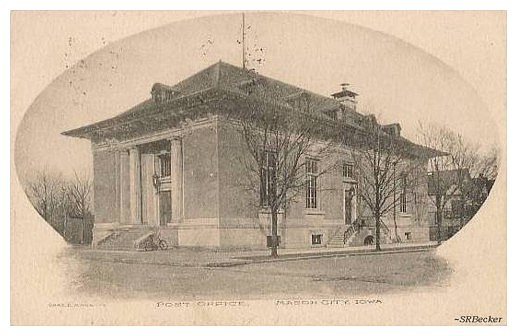
On Dec. 1, 1896, the postoffice, then on the site of the present Yelland Hanes store, was destroyed by fire. It didn't get another permanent home until Feb. 16, 1909, when it was moved to the old Federal Building, now [1953] the City Hall. Postal savings was started on Oct. 10, 1911, and Jan. 1, 1913, saw the beginning of parcel post service in Mason City. The postoffice was moved to the new Federal Building Dec. 24, 1932.
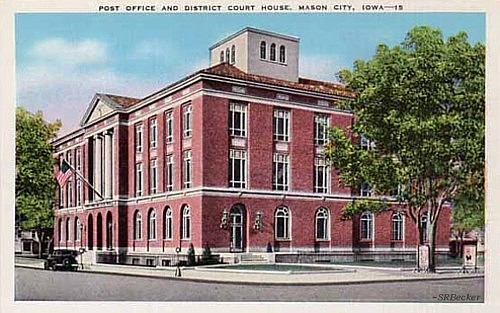
It was in 1902 that Mier Wolf started a furniture business in a small room that housed $500 worth of new and second hand furniture. This grew to be Mier Wolf & Sons, the largest business of its kind in this area with stores in Mason City, Austin, Minn., and Albert Lea, Minn. Mier Wolf was assisted by his four sons, Louis Wolf, president and general manager; Abbott Wolf, vice president; William B. Wolf, manager of the Austin store, treasurer; and, George Wolf, who was manager of the Albert Lea store until he recently left for Phoenix, Ariz., secretary.
MAIL CARRIERS in 1894

[Section 4, Page 15] Mason City mail carriers in 1894 are shown above and from left - Eugene McEwen, William Terrill, Bert Cole and Ed Arquette. The postoffice then was on the present [1953] Yelland & Hanes site. Two years after the building was gutted by fire which destroyed all the books and records of the local postoffice.
MIER WOLF AND SONS
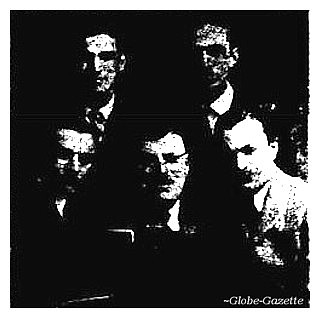
NOTE: Mier Wolf was born in 1871, and died in 1938; his wife Sicol Wolf was born in 1871, and died in 1953.
Abbott E. Wolf was born September 2, 1902, and died February 19, 1979; his wife Marie G. Wolf was born
May 14, 1902, and died April 21, 1977. Louis Wolf was born in 1900, and died in 1978; his wife Bernice S. Wolf
was born in 1905, and died in 2002. Interments were made at Elmwood-St. Joseph Cemetery.
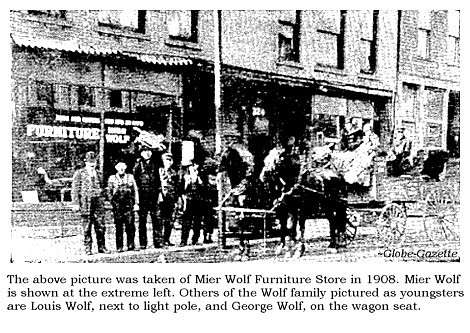
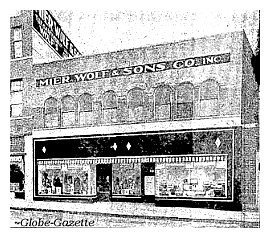

SERVED AS MAYOR
[Section 4, Page 15] George W. Brett, pioneer leader in the community and large land owner in Cerro Gordo County, was mayor of Mason City from 1902 to 1904. NOTE: George W. Brett was born in 1848, and died in 1936. Alice A. Brett, George's wife, was born in 1851, and died in 1938. They were interred at Elmwood-St. Joseph Cemetery.
1903: CLEAR LAKE CLOUDBURST SENDS FLOOD INTO WILLOW CREEK [Section 4, Page 15] Fifty years ago - in that eventful year of 1903 - the world was poised on the edge of the Air age. Globe-Gazette readers in December of that year read dispatches from Norfolk, Va., that a successful trial of a flying machine was made near Kitty Hawk, N. C. by Wilbur and Orville Wright of Dayton, O. The Wright's machine, it was stated, had flown at eight miles an hour AGAINST a 21-mile-an-hour wind. The machine, the story added, "has no balloon attachment but gets its force from propellers worked by a small engine."
In Mason City 1903 had not been without history making events. One of the severest floods in the history of the city occurred on Aug. 3, of that year, when a cloudburst at Clear Lake sent a terrific volume of water down Willow Creek. The water came up to the floor boards of the old bridge over S. Federal.
A. R. Sale, who for 25 years had been engaged in school work in the county, assumed the secretaryship of both organizations, a position he held until 1931 when Philip R. Jacobson became secretary of the Iowa Retail Hardware Association, and R. D. Austin became the secretary-treasurer and general manager of the insurance association, which is now the Iowa Hardware Mutual Insurance Company. NOTE: Arthur R. Sale, born in 1853, died in 1942, interment was made at Elmwood-St. Joseph Cemetery. As soon as the insurance company was organized it set up a campaign to sell fire insurance policies to members of the Iowa Retail Hardware Association. Since Austin assumed the managership the company's business has skyrocketed and as it observed its 50th anniversary is licensed to do business in 23 states and has $376 million of insurance in force. C. A. Knutson, Clear Lake, is president. The Iowa Retail Hardware Association has also added services undreamed of in the early years of the organization and has a program that is the envy of other state associations of its kind.
NATIONAL GUARD AT CLEAR LAKE
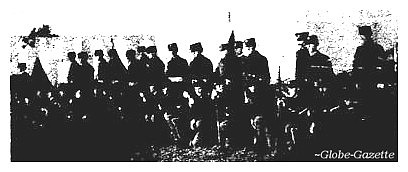
[Section 4, Page 15] Mason City has from pioneer days been National Guard minded. The above picture shows Mason City Company A of the 56th Regiment of the Iowa National Guard at state camp in Clear Lake in the summer of 1903. The picture was provided by J. H. Lepper.
Unless otherwise noted, photographs courtesy of The Globe-Gazette.
|
Return to Centennial "Age of the Iron Horse" Index Page Return to Mason City Centennial Index Page Return to History Index Page Return to Cerro Gordo Home Page